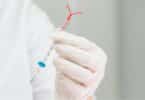During pregnancy, a mother’s blood contains her unborn child’s DNA sequence. This new discovery could make testing for genetic defects and diseases before birth even easier for doctors to do.
A child has half of its DNA from the mother, and half from the father. But a new scientific discovery has found that this unique DNA mixture can be found in the mother’s blood during pregnancy. Tracking this sequence would allow doctors to use it, rather than amnio fluid, to test unborn children for many genetic problems that can occur.
The usual means of testing involves removing some of the amnio fluid, a procedure called amniocentesis. Though helpful, many women have worried about getting the test done as it increases the risk of miscarriage. To get away from this risky procedure, doctors have been looking for other ways to get samples of fetal DNA. Now they have it.
Chemical pathologist Y. M. Dennis Lo, now at the Chinese University of Hong Kong, along with his colleagues found that nearly 10 percent of the DNA fragments in a pregnant woman’s blood actually belong to her child. The fragments come from the normal shedding of dead cells from the placenta and the child as it grows. Unfortunately, getting to these unique pieces of DNA has been tricky to do.
To overcome the obstacle, Lo has begun using powerful DNA-sequencing techniques that can quickly sequence all of the DNA in a blood sample. The scientists were able to track out the fetal DNA from the mother’s blood and use it to test for possible defects and mutations. All without the risk of miscarriage that traditional amniocentesis can bring.
“We have worked out the principle and achieved the first noninvasive genetic scan of a fetus from the mother’s blood,” says Lo, whose team reports its findings online today in Science Translational Medicine.
Despite this amazing breakthrough, the technology will not likely be readily available to all doctors. The type of DNA sequencing required to separate out the fetal DNA from the mothers is extremely costly. Interpreting the results of the sequencing is also very complex. Most clinics and doctors will not be able to afford the tools and understand what the results mean. However, like with many technologies, the process will hopefully become easier and more reasonably priced in future years. – Summer, staff writer
Related Articles:
- Know Your Baby’s Gender In Just 5 Weeks
- New Down’s Syndrome Test Eliminates Miscarriage Risk
- New Type Of Stem Cell In Amniotic Fluid, Placenta
- Amniocentesis Not Linked To Miscarriage







